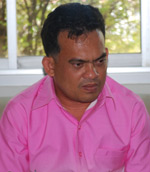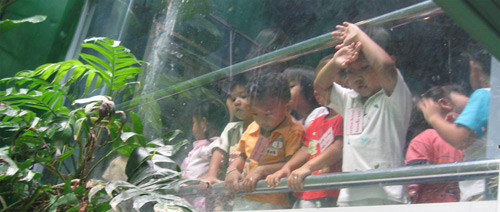Freshwater aquatic centre attracts tens
of thousands of visitors a month
By Peter Starr and Suchart Ingthamjitr*
Aquariums don't need brightlycoloured species and performing mammals to bring in the crowds. If properly managed, recent experience in Thailand shows that freshwater aquariums can generate significant tourism revenues and raise public awareness of fisheries at the same time.

Tourists line up to enter the two
freshwater aquariums at the Bueng
Chawak Exhibition Centre for Aquatic Animals during a weekday
in March
Photo: Lem Chamnap
A lake that loses most of it water in the dry season seems an unlikely place for Thailand's most extensive exhibition centre for freshwater fish and other aquatic animals, especially when it's 160 km from Bangkok. Yet that's what Bueng Chawak in Suphan Buri province has become since 1994 when then Prime Minister Banharn Silpa-archa designated the area as a Royal Development Project to prepare for celebrations marking the 50th anniversary of King Bhumibol Adulyadej ascending the throne in 1946.
The initial work involved excavating the lake to dam up to 10 million m³ of water to irrigate more than 1,000 ha of agricultural land. The next step was to develop the area around the lake in partnership with various departments of the Ministry of Agriculture and Cooperatives, notably the Department of Fisheries, which started building the Exhibition Centre for Aquatic Animals on an island in 1996. The main feature was a freshwater aquarium costing THB 33 million (about US$1.3 million at the time). Other departments of the ministry were involved in establishing a Wildlife Extension Centre and a Garden for Indigenous Vegetables along the lake's shore.

Mr Prasit
Photo: Lem Chamnap
Two freshwater aquariums
Since opening to the public in 1998, the Bueng Chawak Exhibition
Centre for Aquatic Animals has expanded significantly. While
the initial aquarium contained about 50 species, it was considered
too small. So in 2001, the Department of Fisheries decided to
construct a second freshwater aquarium at a cost of THB 51 million
($1.6 million at today's exchange rate). The larger aquarium
opened in 2003 and contains more than 60 species, mostly local
but also some alien species. The expansion, however, raised
operating costs, especially the monthly electricity bill but
also labour costs, with the number of staff almost doubling
from when the centre had only one aquarium. One option might
have been to raise the modest entry fees of THB 30 ($0.90) for
adults and THB 10 ($0.30) for children to levels more in line
with other aquariums in Thailand. But since it was unable to
collect fees to cover its expenses, the Department of Fisheries
in Bangkok decided instead to transfer the aquaticcentre to
the Suphan Buri Provincial Authority, although other parts of
Bueng Chawak remain under the control of the Ministry of Agriculture.
The center's low entry fees may be one of the reasons for its success. When Catch and Culture traveled to Bueng Chawak on a Tuesday in late March 2009, hundreds of tourists including older people and student groups were braving the intense heat to visit the two freshwater aquariums. According to Prasit Watprasit, a former Department of Fisheries biologist who now oversees the facility for the provincial authority, an average weekday sees about 1,000 visitors. The numbers swell to up to 3,000 a day on weekends and up to 5,000 on public holidays. As Prasit noted, the adult entry fee of THB30 is a bargain compared with marine aquariums in Bangkok (THB 450 or $13.60) and Pattaya (THB 250 or $7.60). And although the aquarium in Chiangmai has recently cut adult entries to THB 190, it remains more than six times more expensive to visit than the freshwater aquariums at the Bueng Chawak centre (which also features a crocodile park).
The Bottom Line
Costs of building and running the Bueng Chawak Exhibition Centre for Aquatic Anmials
| Cost | THB | USD1 |
|---|---|---|
| Construction costs | ||
| 1st aquarium (opened 1998) | 33,000,000 | 1,320,000 |
| 2nd aquarium (opened 2004) | 51,000,000 | 1,545,000 |
| Total: | 84,000,000 | 2,865,000 |
| Monthly operating costs (2 aquariums, 3 quarantine facilities, 1 crocodile farm and landscaping) |
||
| Electricity | 300,000 | 9,090 |
| Staff (28)2 | 140,000 | 4,242 |
| Feed and maintenance | 100,000 | 3,030 |
| Total: | 540,000 | 16,326 |
1 Current rates except for 1st
aquarium which is based on rate in 1996 when construction began
2 Monthly salaries range from BHT 4,000 to 6,000
(US$120 to 180)
Thailand's oldest aquarium plans exhibitions for schools

Children visiting the Bangkok Aquarium
Photo: Department of Fisheries
The Bueng Chawak center opened 58 years after Thailand's first aquarium was established at Kasetsart University in Bangkok in 1940. Rebuilt with support from the Canadian government in 1973, the Bangkok Aquarium reopened in 1978 with the aim of contributing to public awareness of freshwater fisheries and promoting fisheries conservation among Thai people. According to Dr. Apichart Termvidchakorn, a fisheries expert at the Inland Fisheries Research and Development Bureau, it is also used to study freshwater species in captivity. The aquarium employs 15 full-time staff (including 4-5 on weekends) and contains more than 60 species including turtles and alien species, which are displayed in a separate section. Specimens are kept in a neighbouring building and are not normally on public display. Monthly operating costs for feed, chemicals and new fish are about THB 25,000 ($760). Additional costs for electricity, water and staff costs are covered by the Department of Fisheries. Dr Apichart says the aquarium receives 300-400 visitors a week, mainly primary schoolchildren. In 2010, he said, the Bangkok Aquarium plans to start special exhibitions for local schools on special themes such as mangroves and watersheds. The aquarium is open from 10 a.m.to 4 p.m. every day except Monday and charges THB 20 ($0.60) for adults and THB 10 ($0.30) for children.
Tunnel vision, giant species
But cheap prices alone don't necessarily guarantee a successful
aquarium. In one province in the Lower Mekong Basin, for example,
the provincial authority offers free entry to its aquarium but
rarely gets visitors as the tanks are poorly maintained. Moreover,
making something free tends to generate a public perception
that it's worthless. According to Mr Prasit, one of the most
important factors behind an aquarium's success is to build a
viewing tunnel, which is precisely what Bueng Chawak did with
the largest tank in the second aquarium. "We received this
idea from visitors," he said. Mr Prasit also emphasised
the importance of stocking tanks with giant species. "These
are seen as special and the public likes them." The largest
tank in the second aquarium, which contains 400 tonnes of water
compared with 28 tonnes in the biggest tank in the first aquarium,
features several large species including two Mekong giant catfish
(Pangasianodon gigas) each weighing
more than 110 kg.
In designing display tanks, Mr Prasit recommended using glass in smaller tanks holding 1, 2 or 3 tonnes of water and acrylic for larger tanks, especially those holding more than 10 tonnes. Another important factor is to keep the water as clean as possible. In the case of the Bueng Chawak centre, Prasit designed his own filtering system for individual tanks mounted into walls to replace a common filtering system used by all the tanks.

Children visiting the aquariums at
the Bueng Chawak centre In March
Photo: Lem Chamnap
Political will
But perhaps the most important factor to ensure an aquarium's
success is to have the political will to ensure that funds are
available for maintenance to be carried out. In this case, the
center still enjoys strong support from former Prime Minister
Banharn, who usually visits Bueng Chawak every Sunday. He is
usually accompanied by with Somwang Phimonbut, the former director
of the Suphanburi Inland Fisheries Research and Development
Centre who played a key role in establishing the Bueng Chawak
centre and now heads the national Inland Fisheries Research
and Development Bureau in Bangkok. He is also credited with
pioneering Thailand's breeding of the soldier croaker (Boesemania
microlepis), an indigenous Mekong species which is also
native to Suphan Buri (so much so that a local area is named
after the fish, known as pla ma or
"horse fish" in Thai).
Bueng Chawak has meanwhile been promoting itself to domestic tourists through its own magazine published every second month. Available for THB 35 ($1.06), the glossy publication is now in its fifth year with Mr Banharn chairing the editorial panel. And while Suphan Buri may not be among the hot destinations for foreign tourists visiting Thailand, Mr Prasit says growing numbers of foreign tour groups have been coming to the centre over the past couple of years, mainly from China, Korea and Russia. Yet Bueng Chawak is not hedging its bets. In February this year, a third aquarium opened. Unlike the first two aquariums, the new one is devoted to marine species. While it commands higher entry prices of THB 120 ($3.60) for adults and THB 30 ($0.90) for children, the new marine aquarium still remains considerably cheaper than those in both Bangkok and Pattaya.
* Mr Starr is the editor of Catch and Culture and Dr Suchart is the coordinator of the Aquaculture of Indigenous Mekong Fish Species (AIMS) component of the MRC Fisheries Programme.
Choose a newsletter: